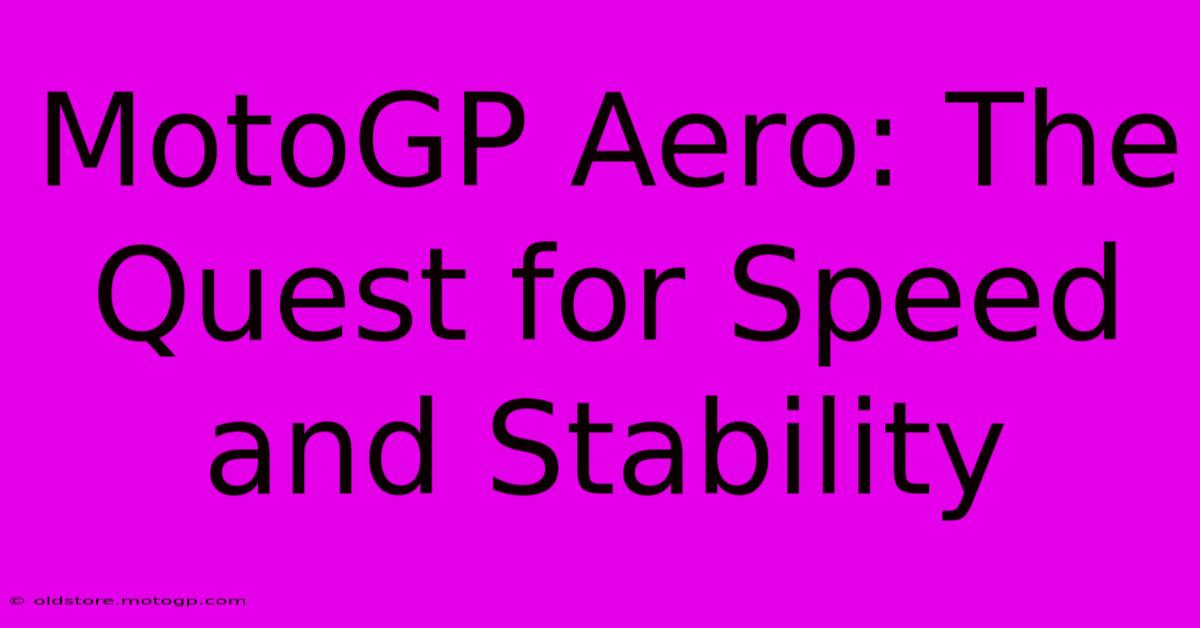MotoGP Aero: The Quest For Speed And Stability

Table of Contents
MotoGP Aero: The Quest for Speed and Stability
MotoGP, the pinnacle of motorcycle road racing, is a relentless pursuit of speed and performance. Every aspect of the bikes, from the engine to the tires, is meticulously engineered for optimal performance. But in recent years, aerodynamics, or "aero," has emerged as a crucial battleground, with teams investing heavily in the development of sophisticated aerodynamic packages to gain a crucial edge. This article delves into the world of MotoGP aero, exploring its complexities and its significant impact on race results.
Understanding the Role of Aerodynamics in MotoGP
Aerodynamics plays a pivotal role in MotoGP, influencing both speed and stability at high velocities. The forces acting on a MotoGP bike at 200+ mph are immense. Effective aero packages aim to:
- Reduce Drag: Minimizing air resistance allows the bike to reach higher top speeds and maintain momentum through corners. Drag reduction is paramount on long straights.
- Increase Downforce: Downforce presses the bike firmly onto the track, enhancing grip, particularly crucial during cornering and braking. More downforce means greater stability and control at high speeds.
- Improve Stability: Aerodynamic components can help stabilize the bike, reducing unwanted movement and making it more predictable and easier to ride, especially when encountering gusts of wind or turbulence.
The Key Aerodynamic Components
Modern MotoGP bikes are festooned with aerodynamic devices, each carefully designed and tested:
- Winglets: These small wings, often positioned on the fairing, generate downforce without significantly increasing drag. Their design is incredibly complex, requiring sophisticated computational fluid dynamics (CFD) simulations. The number and positioning of winglets are constantly evolving.
- Fairings: The fairing itself is a significant aerodynamic component. Its shape and surface are optimized to minimize drag and manage airflow around the bike and rider.
- Wings: Larger wings, positioned on the rear of the bike or even under the swingarm, are used to generate substantial downforce, often at the expense of increased drag. The balance between downforce and drag is key to finding optimal aerodynamic performance.
- Bodywork: Even the smallest details of the bodywork, such as the shape of the fuel tank or the rider's hump, influence airflow and contribute to the overall aerodynamic performance of the bike.
The Constant Evolution of MotoGP Aero
The development of MotoGP aero is a continuous process. Teams are constantly experimenting with new designs, refining existing components, and pushing the boundaries of what's possible. This arms race demands:
- Advanced Simulation Techniques: CFD simulations are essential for predicting the aerodynamic performance of new designs, reducing the need for extensive physical testing.
- Wind Tunnel Testing: Wind tunnels provide crucial data to validate CFD simulations and fine-tune aerodynamic components. This involves intricate testing procedures and data analysis.
- Track Testing: Real-world testing on the track provides invaluable feedback and allows riders to provide essential input on the performance of the aero package. Rider feedback is paramount.
The Impact on Racing Strategy
The impact of aerodynamics extends beyond pure speed. The choice of aero package can significantly influence racing strategy:
- Track Specific Setups: Different tracks demand different aerodynamic setups. A track with long straights might benefit from a low-drag setup, while a track with many tight corners may require a high-downforce setup.
- Rider Preferences: Riders' preferences influence the choice of aero package. Some riders may prefer a more stable setup, even if it means sacrificing some top speed.
The future of MotoGP aero promises even more sophisticated designs and innovative solutions. The quest for speed and stability will continue to drive the evolution of this critical aspect of the sport, leading to even more exciting and closely contested races. As technology advances, we can expect to see even more dramatic changes in the aerodynamic landscape of MotoGP. The interplay between speed, stability, and rider skill remains at the heart of this dynamic motorsport.

Thank you for visiting our website wich cover about MotoGP Aero: The Quest For Speed And Stability. We hope the information provided has been useful to you. Feel free to contact us if you have any questions or need further assistance. See you next time and dont miss to bookmark.
Featured Posts
-
Motorcycle Racing Tactics And Strategies For Different Types
Feb 22, 2025
-
F1 Us Grand Prix Watch On Your Big Screen Tv Guide
Feb 22, 2025
-
Free Moto Gp Live Stream Easy Access Instant Gratification
Feb 22, 2025
-
Capture The Moment Austin Gp 2025 Photography
Feb 22, 2025
-
From Pit Stop To Podium The Red Bull Grand Prix Story
Feb 22, 2025
